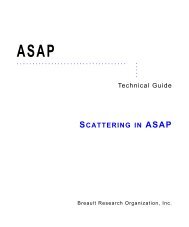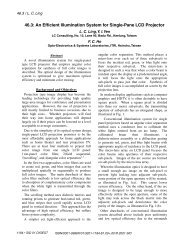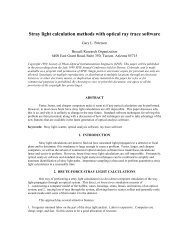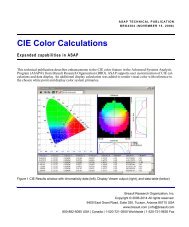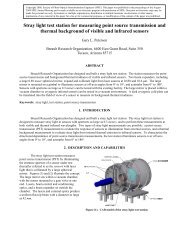diffraction gratings and does - Breault Research Organization, Inc.
diffraction gratings and does - Breault Research Organization, Inc.
diffraction gratings and does - Breault Research Organization, Inc.
You also want an ePaper? Increase the reach of your titles
YUMPU automatically turns print PDFs into web optimized ePapers that Google loves.
DIFFRACTION GRATINGS AND DOESFundamentals of Diffractive Optical Elements. . . . .FUNDAMENTALS OF DIFFRACTIVE OPTICALELEMENTS. . . . . . . . . . . . . . . . . . . . . . . . . . . . . . . . . . . . . . . . . . . . . . . . . . . . . . . . . .Two common approaches exist for calculating the <strong>diffraction</strong> patterns from DOEs:vector calculation <strong>and</strong> scalar calculation.Using vector <strong>diffraction</strong> theory, we can calculate the directions of propagation ofthe various reflected <strong>and</strong> transmitted orders of a beam after interacting with theDOE as well as the fractional power contained in each order. The fractional powerdiffracted into each order is called the <strong>diffraction</strong> efficiency, <strong>and</strong> is determined bythe diffractive surface profile. This complicated calculation involves not only theDOE structural data, but also the physical <strong>and</strong> electromagnetic properties of theDOE. ASAP <strong>does</strong> not perform this type of calculation.Using scalar <strong>diffraction</strong> theory, we can calculate the idealized directions ofpropagation of the various reflected <strong>and</strong> transmitted orders of a beam afterinteracting with a diffractive element. The scalar <strong>diffraction</strong> theory technique isvalid if the grating period is larger than the wavelength of the diffracting light.Swanson notes that the scalar approximation can be used in Maxwell’s equations ifthe grating period is approximately five times the wavelength of the diffractinglight. The <strong>diffraction</strong> orders are selected by adjusting the direction cosines of theexiting beams according to the grating equation. The <strong>diffraction</strong> efficienciescannot be generally or easily calculated with this method since this is a scalartechnique. Most optical design <strong>and</strong> analysis software programs, including ASAP,use this technique since it is adaptable to ray tracing.The grating equation can also be derived from the Huygens-Fresnel principle. Thisis, perhaps, a more physically intuitive derivation than one from scalar <strong>diffraction</strong>theory, yet mathematically less rigorous. Therefore, we use Huygens-Fresnelprinciple to derive the grating equation.Huygens-Fresnel principleChristian Huygens proposed a theory of <strong>diffraction</strong> based upon primary <strong>and</strong>secondary wavefronts. A wavefront is a mathematical surface of constant phase. Ina contemporary, geometrical sense, wavefronts are mathematical surfaces overwhich the optical path lengths from rays of a point source have the same length.Huygens proposed that every point on a primary wavefront can be considered asource of secondary wavelets (or sources), each with the same frequency <strong>and</strong>velocity, such that at a later time, the primary wavefront is the envelope of theASAP Technical Guide 9



